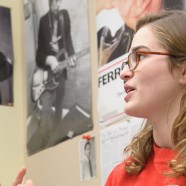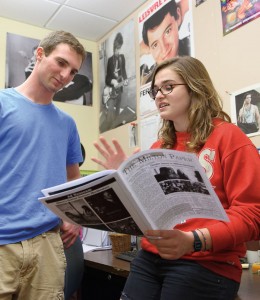
Milton graduates beginning in the late 1980s remember looking forward to Friday mornings, when The Milton Paper, Milton’s independent student newspaper, was hot off the press. With a dedicated following and a proud staff, the Paper has always been a strong publication. When Adam Beckman ’12 and Cydney Grannan ’12 became editors-in-chief, they decided to define and meet a new level of quality, while print and online publications in the public domain were busy sorting out this issue for themselves. What should “their public,” Cydney and Adam effectively asked, be able to expect from reporters, writers and editors?
Cydney and Adam’s top priority was upgrading their peers’ writing. Reaching their goal, the pair thought, would demand bold steps, as editors and leaders. They began by asking former writers to reapply for their positions; committing to reject any articles that didn’t make the grade; appointing at least three editors to every article; and providing constant feedback. Once their student staff was in place, they connected student journalists with professional journalists, on campus, who would talk with them about the field today.
Adam, Cydney and their editorial board independently contacted professionals in Greater Boston. Three career journalists accepted the students’ invitation. The result was a powerful series of intimate workshops and seminars for the staffs of the Paper, and the School’s official student newspaper, the Milton Measure.
Helen Smith—an award-winning journalist who has worked with high school writers for decades—held the first workshop. In a highly interactive class on sports writing, she advised students on topics, writing style, and section layout.
Cynthia Needham ’95, metro political editor for the Boston Globe, spoke with students about the daily schedule and pace of a newspaper. She focused on writing strong ledes, handling difficult interviewees, and keeping personal views out of articles. She answered the student writers’ questions: How do you angle a news article without coming across as biased? What do you do when your sources don’t want you to print the piece? How do you edit without removing the writer’s voice?
Martin Baron, editor of the Boston Globe, concluded the series. In a packed room he spoke about his career experience and the responsibilities of “watchdog journalism.” Mr. Baron focused on the purpose of journalism: to inform on the facts, and to keep people—individuals, organizations, corporations—honest.
The challenges

Adam and Cydney purposefully shifted the look of The Milton Paper this year. For the first time in its 33-year history, the publication would include photography, and layout would become the responsibility of a dedicated staff member. With the help of savvy classmates, they developed and launched The Milton Paper Web site, making room for extended content and broadening their audience. Check out the online version of The Milton Paper at: www.themiltonpaper.org.
Adam and Cydney had to help reporters distinguish between strong English essays and good news articles—especially considering the limited space for news columns, and readers who skim. The Paper’s solution was mini-paragraphs, purposeful layout, and constant feedback.
“Good news writers approach a piece thinking, ‘I didn’t know about this before, and I want to learn about it,’ rather than, ‘How do I feel about this?’” Cydney says. “This is a shift for Milton students, who are used to being asked, ‘How do you feel about Moby Dick?’ and not, ‘What literary tools did Melville use?’”
The team assigned articles that would provoke conversation—on topics like Milton’s sanctuary policy, racial diversity, college counseling, and gender gaps. They achieved unbiased points of view by addressing compelling issues that inherently had two sides.
“It sounds counterintuitive, but we love our School so much that we feel the need to think critically about how it works, and to make it better,” says Adam.
News editors Christine Cahill ’12 and Hannah Grace ’12 demanded that writers include multiple sources. “If you’re writing an article about a School policy that isn’t popular with students and the whole article is quotes from students, that’s probably not a balanced approach,” says Adam.
Cydney says that getting students to read The Paper, instead of flipping immediately to the humor page, was a major goal. “It sounds like a humble goal, but it’s a big one,” she says. “At the same time, our largest and most thoughtful readership is the faculty and administration. We have to take our whole audience into consideration— that includes parents, grandparents and alumni, too.”
The Paper’s broad audience was one reason the editors didn’t publish the traditional “sin poll” this year. In theory, this feature showed statistics drawn from anonymous polling of Milton students’ supposed transgressions. Adam and Cydney acknowledge that the information had typically been inaccurate and fabricated for shock value. “Even though that was a popular issue with students, we had to ask what purpose it served,” Cydney says. “We wanted to provide a full and accurate picture of Milton to people outside of the community. Blowing something out of proportion isn’t reporting on the facts.”
The two relied on each other and on their editorial team—Hannah and Christine, Keyon Vafa ’12 and Henry Green ’12— in making decisions and initiating diffi cult conversations. By the middle of the year, their staff understood clearly what the standard was each week. They realized that, in print, their words were powerful and lasting.
Another challenge for Cydney and Adam was finding balance. They wanted to create the best product possible each week, but at what cost? For instance, Adam asked, at what point does it stop making sense for Cydney to rewrite an editorial for the fourth time?
“Sometimes I felt the value of my work, which had taken hours, was diminished when it ran beside a piece that someone spent 30 minutes writing and didn’t research well,” says Cydney. “The truth is that people have different priorities. The Paper was a part-time job for me, but it was just one of many activities for some of our writers. They were all, in the end, high school volunteers. I learned not to put a value judgment on that commitment.”
Cydney and Adam entered The Milton Paper into the American Scholastic Press Association (ASPA) Annual Review and Contest Awards this spring, hoping to gain useful feedback as they shaped and changed the publication. They won first place in their classification. The ASPA awards points and provides detailed advice on page design, story layout, graphics, headlining, cover design, advertising placement, photography and a variety of other elements. The Milton Paper received a total of 870 points out of 1,000. Some of the highest-ranked areas included content coverage and page design, two areas the editors focused on this year.
Another balancing act was tending relationships with interviewees and sources. Finding the truth while maintaining trust was key. “Being dogmatic with the administration might work one time, but probably not twice,” says Cydney. Some faculty members would only allow writers to quote them if they could review the article before it went to print. After discussing the matter with the Paper’s faculty advisor, Paul Archer (Classics), Adam and Cydney decided that submitting quotes for review would detract from the integrity of the Paper and from their learning process. “If a source or a reader approached us with a strong reaction—especially a negative reaction—to something we printed, that would resonate,” says Adam. “It would make us think and defend what we wrote, or perhaps concede that we could have done things differently. Giving others access to the writing before it made it to print would have been too much of a safety net.”
Taking a risk, publishing something, and then dealing with the reverberations is a real, live process in the blogosphere. People publish their opinions, or make mistakes, and readers comment immediately. Missteps go viral, and writers learn how accountable they are.
The takeaways
“This job might have been one of the trickiest working situations I’ll ever be in,” says Adam. “I’m managing my six best friends from high school, who are working for free! I’m critiquing their work and making decisions they’re not happy with, all while meeting deadlines.
“That said, I’ve learned how to work with very smart and talented people, and I know the importance of hearing different perspectives. You have to let go of your opinion being the most important. I’ve been surprised and impressed by how well we’ve learned to disagree with one another. We had honest conversations and then moved on. It was a bizarrely mature experience.”
“At the beginning I reacted emotionally to people disagreeing with me, or disliking my editorial,” says Cydney. “I had to break it down: What does it mean that I disagree with this person? What does it mean that we didn’t go with my editorial this week? Approaching issues logically, keeping them in a rational perspective, made them easier to process. I’ve become better at that. I’ve developed a thicker skin, and I’m more confi dent in handling myself that way.”
“Sometimes we struggled with our editorials,” adds Adam. “Writing a 500-word piece, every week, about something signifi cant at Milton was hard. The upside is that every week six students were thinking critically for fi ve hours about a single facet of the School. That was one of our main contributions: refl ecting on what we like about this place and what we’re proud of; what displeased us this week, how we would change it, and moving others to think about it, too.
“There’s nothing better than overhearing someone say, ‘Did you read that article?’ or ‘I really disagree with that.’ We loved talking with people who had a problem with something we’d written, because it meant they were reading! For those nine months, if I had something to say, I could write about it, or talk about it with someone else who would write it. We had a venue to be heard. What a privilege.”
–Erin E. Berg



